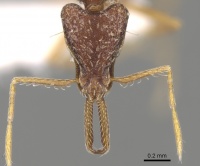Strumigenys micretes
| Strumigenys micretes | |
|---|---|

| |
| Scientific classification | |
| Kingdom: | Animalia |
| Phylum: | Arthropoda |
| Class: | Insecta |
| Order: | Hymenoptera |
| Family: | Formicidae |
| Subfamily: | Myrmicinae |
| Tribe: | Attini |
| Genus: | Strumigenys |
| Species: | S. micretes |
| Binomial name | |
| Strumigenys micretes Brown, 1959 | |
Strumigenys micretes occurs in wet forest habitats. It nests in dead wood on the ground (Longino, Ants of Costa Rica).
Identification
A member of the Strumigenys emeryi-group. See Strumigenys emeryi
Longino (Ants of Costa Rica) - Apical fork of mandible with one intercalary tooth; mandible often with acute preapical tooth very close to apical fork, but may be reduced to small denticle or absent; no other preapical teeth; gaster smooth and shining, with long flagelliform setae; pronotal dorsum finely reticulate-punctate, usually without any costulate sculpture; but if a few faint costulae occur they are insignificant and obviously secondary to the reticulate-punctate component.
Keys including this Species
Distribution
Latitudinal Distribution Pattern
Latitudinal Range: 19.51666667° to 8.407045°.
| North Temperate |
North Subtropical |
Tropical | South Subtropical |
South Temperate |
- Source: AntMaps
Distribution based on Regional Taxon Lists
Neotropical Region: Costa Rica (type locality), Honduras, Nicaragua.
Distribution based on AntMaps
Distribution based on AntWeb specimens
Check data from AntWeb
Countries Occupied
| Number of countries occupied by this species based on AntWiki Regional Taxon Lists. In general, fewer countries occupied indicates a narrower range, while more countries indicates a more widespread species. |

|
Estimated Abundance
| Relative abundance based on number of AntMaps records per species (this species within the purple bar). Fewer records (to the left) indicates a less abundant/encountered species while more records (to the right) indicates more abundant/encountered species. |

|
Biology
Castes
Nomenclature
The following information is derived from Barry Bolton's Online Catalogue of the Ants of the World.
- micretes. Strumigenys micretes Brown, 1959a: 100 (w.) COSTA RICA. See also: Bolton, 2000: 516.
Unless otherwise noted the text for the remainder of this section is reported from the publication that includes the original description.
Description
Worker
Bolton (2000) - TL 2.7-3.2, H L 0.68-0.75, HW 0.47-0.54, CI 69-75, ML 0.42-0.47, MI 60-65, SL 0.48-0.54, SI 96-102, PW 0.30-0.35, AL 0.68-0.76 (12 measured).
Preapical dentition of mandible very variable: may be entirely absent but usually there is a denticle or small tooth (size variable) on one or both mandibles close to the apicodorsal tooth. This denticle/tooth may be larger on one mandible than on the other, or present on one but not the other. More proximally mandible unarmed, or one or both with a minute denticle or tumulus. Considerable variation may occur within a single nest series. Both pairs of standing hairs on cephalic dorsum stiff, simple to spatulate. Apicoscrobal hair and pronotal humeral hair flagellate; a flagellate pair present on mesonotum and similar hairs numerous on waist segments and first gastral tergite. Pronotal dorsum reticulate-punctate, often only this sculpture present but sometimes a few very feeble superficial rugulae may occur; if so the rugulae are very faint, widely spaced and distinctly secondary to the reticulate-punctate sculpture. Mesopleuron, and usually also metapleuron, with a smooth unsculptured area; presence and extent of smooth area on metapleuron variable and in some specimens the entire sclerite is reticulate-punctate. Posterior (free) margin of propodeal lamella straight to weakly convex for most of its depth; propodeal lacuna conspicuous. Ventral surface of petiole with a curtain of spongiform tissue. Dorsum of petiole node reticulate-punctate. Disc of postpetiole variably sculptured, mostly smooth in some, in others smooth with peripheral weak sculpture or the whole surface feebly superficially sculptured; sometimes one or two weak rugulae present dorsolaterally.
Type Material
Bolton (2000) - Holotype and paratype workers, COSTA RICA: Santa Clara Prov., Colombiana Farm, 1924 (W. M. Mann) (National Museum of Natural History, Museum of Comparative Zoology, Museu de Zoologia da Universidade de Sao Paulo) [examined].
References
- Bolton, B. 2000. The ant tribe Dacetini. Memoirs of the American Entomological Institute. 65:1-1028.
- Brown, W. L., Jr. 1959. The neotropical species of the ant genus Strumigenys Fr. Smith: group of emeryi Mann. Entomological News. 70:97-104. (page 100, worker described)
- Brown, W. L., Jr. 1962c. The neotropical species of the ant genus Strumigenys Fr. Smith: synopsis and keys to the species. Psyche. 69:238-267.
References based on Global Ant Biodiversity Informatics
- Adams, R.M.M. and J.T. Longino. 2007. Nesting biology of the arboreal fungus-growing ant Cyphomyrmex cornutus and behavioral interactions with the social-parasitic ant Megalomyrmex mondabora. Insectes Sociaux 54:136-143
- Bolton, B. 2000. The Ant Tribe Dacetini. Memoirs of the American Entomological Institute 65
- Dattilo W. et al. 2019. MEXICO ANTS: incidence and abundance along the Nearctic-Neotropical interface. Ecology https://doi.org/10.1002/ecy.2944
- Fernández, F. and S. Sendoya. 2004. Lista de las hormigas neotropicales. Biota Colombiana Volume 5, Number 1.
- Kempf, W.W. 1972. Catalago abreviado das formigas da regiao Neotropical (Hym. Formicidae) Studia Entomologica 15(1-4).
- Longino J. T. L., and M. G. Branstetter. 2018. The truncated bell: an enigmatic but pervasive elevational diversity pattern in Middle American ants. Ecography 41: 1-12.
- Longino J. T., J. Coddington, and R. K. Colwell. 2002. The ant fauna of a tropical rain forest: estimating species richness three different ways. Ecology 83: 689-702.
- Longino J. T., and R. K. Colwell. 2011. Density compensation, species composition, and richness of ants on a neotropical elevational gradient. Ecosphere 2(3): 16pp.
- Longino J. et al. ADMAC project. Accessed on March 24th 2017 at https://sites.google.com/site/admacsite/

